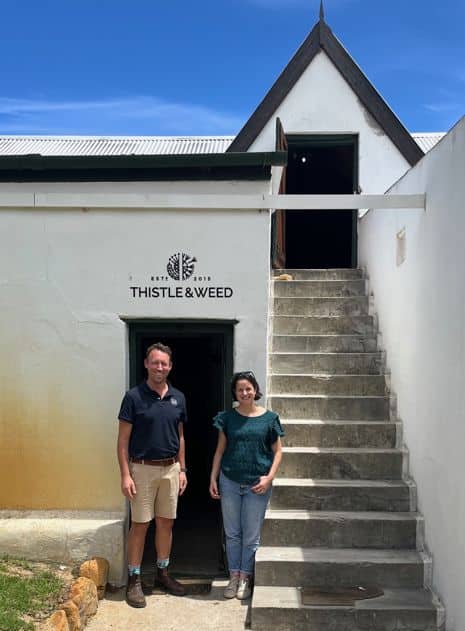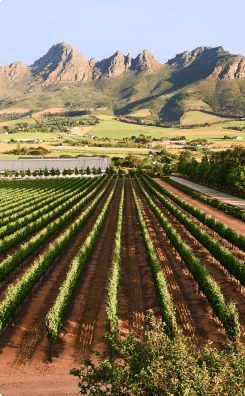Tim James: A new sparkling from Thistle & Weed joins this fine range
By Tim James, 17 November 2025

Until last week, I hadn’t been in the little old Leef-op-Hoop winery in Stellenbosch’s Jonkershoek valley for I don’t know how many years. Previously it was to visit Etienne le Riche, who established his own brand there after leaving Rustenberg in 1996 and left it in 2013 to build his own winery (taking with him the measurements of the cement fermentation tanks, the kuipe, to reproduce them as closely as possible).
This time it was another Etienne I saw there, viticulturist Etienne Terblanche – VinPro consultant and, more to the present point, winemaking partner to Stephanie Wiid in the Thistle & Weed project, celebrating its first ten years around now. My visit worked as a happy illustration of what I was writing about last week – the significance in the Burgundisation of Cape wine of close teamwork (and occasional identity) between cellar and vineyard practitioners.
Stephanie and Etienne rented the cellar a few years back, as a home for their brand – somewhere to have visitors for tastings, but also for making at least their red wines. Pending the necessary equipment, their whites are are still being made in borrowed space at Avondale. Meanwhile, they’ve been smartening and patching up the cellar, and installing a resident assistant winemaker in the person of Schalk Viljoen (even younger than they are – the hungry generations are treading me down relentlessly).
Site-specific Chenin, unusual blends and a new bubbly
My visit was particularly well timed, as Thistle & Weed has just released a new wine, a delicious and unpretentious and properly dry sparkling from chenin. Contrasting with their well-established speciality of chenins from old vineyards, this is from younger vines (off Knorhoek in Stellenbosch). Younger chenin vines, especially from higher, cooler slopes like these, give a particular vibrancy, Stephanie and Etienne feel, and that certainly shows here in the appley freshness and grippiness (without aggression). It’s called Vinkel, for the fennel that now grows widely and wild in the Cape, and so features another in the series of Thistle & Weed’s charming, floral labels. There’s no fussy foil over the wire cage holding down the cork, and it’s just called Brut (no “Cap Classique”). Sparkling from chenin is certainly not unprecedented in the Cape, though it’s by no means as common here as it is in chenin’s other great heartland, and homeland, the Loire Valley, but this is a very welcome addition (and well-priced at R250) – especially as a classically made wine rather than a méthode ancestrale, of which we have, I think, enough thanks.
There’s every reason to welcome another chenin from this team, especially a complementary offering. I also tasted the three others they make, also 2024s, and they each evidence a welcome, defining characterfulness based on their diverse origins (they’re all made in essentially the same way). Springdoring from 1982 Paardeberg vines is particularly light and bright – thanks to the granitic soil and to early picking – and with a delicious twist of greenness to the finish. Duwweltjie is from vines planted on Paarl koffieklip soil in 1961, and is almost perfumed in its aromas, with fuller, deeper fruit (stonefruit and the pineapple that Stephanie finds a percurrent, defining feature) and a richer texture. Pushing the broadness and depth and power is Brandnetel – like the new Vinkel from Knorhoek in Stellenbosch, but from the older vineyard (1980) there that also supplies the fine Knorhoek Chenin. Like all these wines, it’s beautifully dry, but there’s a notably succulent kernel of sweet fruit here.
The chenins are R375 each, and fair value as top quality chenin goes. Even better value, I’d say, is the Khakibos White Blend at R295 (these prices all from their website, which also offers various mixed cases). Khakibos is largely Iberian-inspired: there is chenin, but in 2024 also verdelho, alvarinho, palomino and Fernão Pires. It makes for a wonderfully complex, beautifully structured and absolutely gorgeous drink.
As for the reds, the 2023 Nastergal, like Khakibos from vineyards across the Western Cape and similarly priced, is from alicante bouschet, touriga nacional, souzão and touriga francesa. No pontac, I noticed, having written enthusiastically about its pioneering but untrumpteted inclusion in the 2021. The grape is proving to be pretty problematic, says Etienne, and the source vineyard is no more – although they have a final bottling of it coming up. (Reminder: check up on other peoples’ expected pontacs!) Anyway, without it, Nastergal is bigger and bolder than I remember the 2021 as being; lots of juicy fruit, but for me perhaps something of an outlier in Stehanie’s pretty classical range. The straight cab franc from Polkadraai, Knapse Kêrel 2024 seems a better companion to the whites: a ripe 14% alcohol, but fresh and fairly light-feeling, with some dried-herbal notes and a pleasant hint of green on the finish.
All in all, a range to warmly recommend, with a special welcome to the Vinkel Brut. And sitting outside the modest winery, with the oaky charm of Jonkershoek all around, is a particularly pleasing way of learning about these wines. It’s just a hop from the frantic centre of Stellenbosch town, but much further than that in spirit, so worth visiting yourself or sending friends; appointment required, however.
- Tim James is one of South Africa’s leading wine commentators, contributing to various local and international wine publications. His book Wines of South Africa – Tradition and Revolution appeared in 2013.








Comments
0 comment(s)
Please read our Comments Policy here.